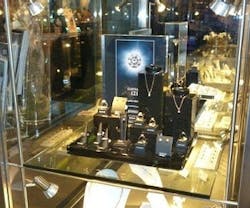Retail lighting applications have many unique performance requirements that until now have mostly been met by incandescent sources for directional lighting, and fluorescent sources for ambient lighting. Only recently have LED sources evolved that meet and surpass traditional sources in performance. New products and systems promise an exciting world of possibilities and flexible design options.
Retailers are a unique customer group for lighting products because they realize the importance of aesthetics and customer experience more than owners of commercial, industrial, and office buildings. They’re also more willing to invest in lighting in their facilities because of its direct impact on sales. Unlike other buyers, energy savings is a lesser concern for them, but operations and maintenance is frequently as important or more important than for other market sectors.
For retailers, LED lighting solutions must deliver high color consistency and color rendering, low maintenance costs, high directional output, high compatibility, and be available in a wide range of lamp types suitable for different layers of light typical to stores. These types include:
- Case lighting
- Decorative or ornamental lighting
- Floor display
- General lighting
- Wall display
In hospitality and food and beverage retailing, spectral control and dimming are important as well. Some leading LED manufacturers now offer a range of LED products that meet all of these requirements.
Quality Lighting Changes Customer Experience
Good retail lighting and aesthetics make a dramatic difference in how customers experience store environments, brands, and products. Color rendering has a decisive impact on how vibrant and alive products (and people) appear. High CRI (>90) directional lamps, available in a full range of correlated color temperatures (CCTs), now give retailers the same or better color rendering performance as traditional incandescent sources.
Lower color temperature lamps that completely replace incandescents for use in restaurants and hospitality are even available in CCTs as low as 1600. Also, because LEDs are so flexible, high CCT sources in the 4000K range suitable for use in jewelry display are also available in high CRI. This is particularly useful as sources like this provide great color rendering for jewelry and skin alike, so when a customer tries on a bracelet or watch, the product looks great and she or he doesn’t look like a cadaver. This improves customer experience.
Good Lighting Makes Exploring Surroundings Easier
Another profound effect of lighting is on circulation and navigation in a store. Well balanced lighting directs customers to focal areas where important products are easily seen and accessed, and can drive a customer’s journey through a space in a way that maximizes sales.
Ambient (diffuse) lighting sets the mood and provides contrast to focused directional lighting, which retailers use to provide drama and magic to products and displays. When visual priorities are carefully balanced, customers see the most important things first. This improves the feeling of comfort and the overall customer experience, enhancing the brand of the store and the brands and products it carries.
Color consistency is an ongoing issue with retail lighting in recent years as ceramic metal halide sources have been widely used in retail. One of their major drawbacks is color degradation over a relatively short lifetime resulting in the need for frequent replacement of lamps—a cost retailers would gladly do without. A similar problem occurs with a lamp much beloved by retailers for its small size, clean crisp beam, and warm color temperature, the halogen MR16, as their dichroic coatings tend to burn off after 2,000 hours or less, creating color shift problems.
While controls and dimming are a huge concern for retail display lighting, for hospitality and food and beverage lighting they are elemental to setting the mood and making people feel comfortable. Warm dimming, where color temperature drops with light levels like incandescent sources, is very new to LED technology.
Who has this technology?
A few leading LED lamp manufacturers are now releasing lamps with sophisticated dimming technology, that not only adjust the light output strength while being dimmed, but also gradually transform from a bright soft color temperature (2700°K) at the highest level, to a warm flame color (1600°K) at the lowest dimming level. Or, for instance, from a daylight approximate CCT of 4700K to a warm white 2700K. These capabilities meet and exceed the performance of incandescent sources, and make it possible for a single lamp type to meet the need for dynamically changing conditions in stores, hotels, and restaurants.
Operations and maintenance is a real concern for most retailers. Smaller stores typically don’t have maintenance staff, and using sales staff to change hot directional incandescent bulbs frequently (typical lifetimes can be 2,000 hours or less) means not only downtime and unhappy sales staff, but also lost sales. Most quality LED manufacturers now offer three or even five year warranties with 24-hours/day use – approximately 25,000 hours of guaranteed illumination - a distinct advantage to all retailers.
While LED products now provide all the performance benefits of traditional sources, it will be several years before all retail lighting is LED based. Many retailers today are in a continual transition stage of adopting the latest lighting retrofit solutions while retaining much of their legacy lighting infrastructure. As a result, most retail environments seem to be a patchwork of different lighting systems, lamp types, and lighting designs. Take sales into your hands by considering a LED lighting retrofit in your retail store.
Jan Kemeling – Ledzworld Chief Sales & Marketing Officer (CMO)
Jan co-founded Ledzworld in December 2008 and lived and worked in Asia since 1990. Jan has founded and managed several companies in China, Hong Kong, Malaysia and Indonesia. He has in-depth knowledge of the design, (outsourced) large scale manufacturing, and worldwide distribution of products for the consumer electronics industry. In 2006 Jan was awarded with the prestigious China Trader’s Award, by the Dutch ambassador in China. Jan holds a Bachelors degree in marketing management (The Hague, The Netherlands).
